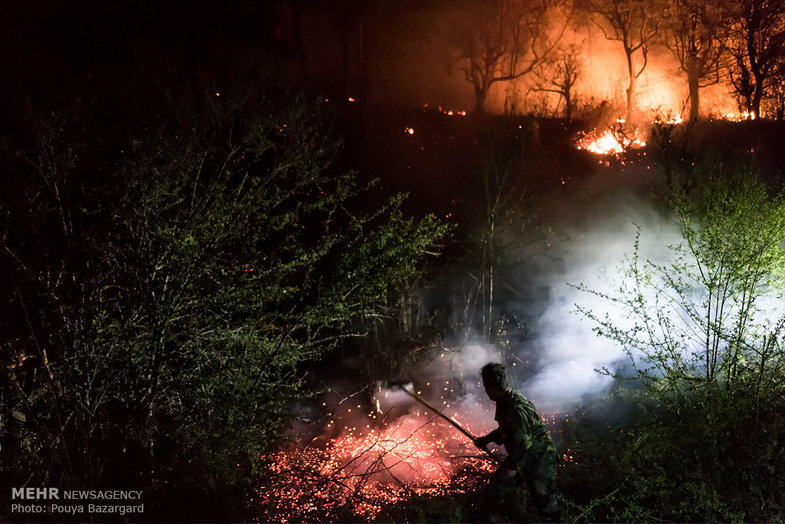Wildfire burns 400 ha of protected areas within 3 months

TEHRAN – Some 400 hectares of the protected areas turned into ashes due to raging wildfire, since the beginning of the current Iranian calendar year (March 21), head of the Department of Environment’s (DOE) protection unit has stated.
In Iran, areas protected by the DOE cover 17 million hectares which fall into four categories: national parks (22 sites), wildlife refuges (34 sites), protected areas (93 sites), and national nature monuments (20 sites).
He went on to say that so far wildfires broke out in 14 provinces, mostly in areas located near the Zagros foothills, such as of Kohgiluyeh and Boyerahmad, Chaharmahal and Bakhtiari, Lorestan, Fars, northern provinces and Tehran.
Two week earlier, raging wildfire erupted in Khaeez protected area in Kohgiluyeh and Boyer-Ahmad province, southwestern Iran, which affected some 1,783 hectares of the lands.
Provinces of Kalgiluyeh and Boyer Ahmad, Tehran set record highs for the wildfires, IRNA news agency quoted Jamshid Mohabbat Khani as saying on Sunday.
Heavy rainfalls increase wildfire risk
Torrential rains over the past few months, had positive consequences like saturating the wetlands and reservoirs, however, led to some natural incidents like flooding or wildfires, as the plants and vegetation has grown in vast areas of forests and rangelands which soon turned dry due to temperature rise which enhances the possibility of massive fires.
Based on the latest data published by National Drought Warning and Monitoring Center affiliated to Iran’s Meteorological Organization, since the current crop year (September 23, 2018), precipitation in the country increased to 310.2 from 159.9 millimeters in the previous water year, demonstrating a 94.9 percent rise. The amount also raised in comparison to the long-term average of 222.2 mm, amounting to 39.6 percent.
Human errors leading cause of massive fires
Mohabbat Khani also highlighted that 62 cases of wildfires caused 400 hectares of the protected areas to turn into ashes since past three months, out of which 8 cases sparked by lightening.
While most of the fires were human-caused or ignited due to litter and waste left in the nature by the humans, somehow direct or indirect role of human is the leading cause of such incidents, he added.
Two human errors are the most important causes of wildfires, one is throwing glass bottles on the side of the roads or inside the forests which magnifies a ray of sunlight, igniting grass around it, and the other one is leaving a fire unextinguished; some of the people camping in the nature do not ensure that the fire is completely put out, he further explained.
In such situation, extinguishing the massive fire is difficult because the dry plants flare easily and quickly, he noted, adding, this year, 18 rangers burned during fire extinguishing operations; rangers are not firefighters having heat-resistance clothes, so they are in danger.
Although, we have provided them with some facilities to put out the fire, people must well cooperate to reduce the danger, he added.
Public co-op, awareness, major way to prevent wildfires
Mohabbat Khani further called on the people to be cautious while camping in the environment and take safety precautions as well as not leaving the waste in the environment.
Wildfire in impassable areas makes any fire-fighting operation almost impossible and only helicopters could reach the area, which have a long process to use aerial firefighting, in addition, the helicopters are not allowed at nights, he also lamented.
This year, with expanded vegetation cover wildfire risk has highly increased which is unprecedented in past 30 years, he also stated.
The DOE has employed its whole capacity as a “rapid response team” to combat wildfires, but still the main way to overcome such occurrences is raising public awareness and cooperation, he concluded.
In early-May, Hamid Zohrabi, DOE deputy chief for natural environment and biodiversity directorate, said that in the current year (started on March 21), above-normal precipitation and increased vegetation covers can dramatically heighten the risks of wildfires, however, due to slower-than-usual temperature rise in many regions in the country it is projected that wildfire season might be delayed.
Qasem Sabz’ali, commander of the forest protection unit of the Forests, Range, and Watershed Management Organization, said in April 2018 that some 15,000 hectares of forests burn in wildfires annually in Iran that 95 percent of them are caused by humans, ISNA reported.
Forest wildfire brings heavy economic burden amounting to 560 million rials (about $13,000) per hectare for the country, he added.
FB/MG
